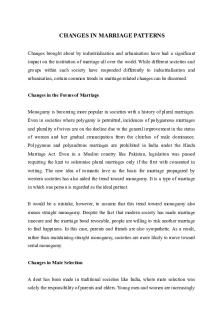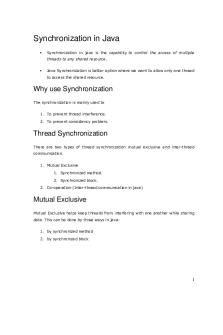Design Patterns in Java Tutorial PDF

| Title | Design Patterns in Java Tutorial |
|---|---|
| Author | Err Adil |
| Pages | 168 |
| File Size | 1.7 MB |
| File Type | |
| Total Downloads | 477 |
| Total Views | 826 |
Summary
Design Patterns in Java Tutorial DESIGN PATTERNS IN JAVA TUTORIAL Simply Easy Learning by tutorialspoint.com tutorialspoint.com i ABOUT THE TUTORIAL Design Patterns in Java Tutorial Design patterns represent the best practices used by experienced object-oriented software developers. Design patterns ...
Description
Design Patterns in Java Tutorial
DESIGN PATTERNS IN JAVA TUTORIAL
Simply Easy Learning by tutorialspoint.com
tutorialspoint.com i
ABOUT THE TUTORIAL
Design Patterns in Java Tutorial Design patterns represent the best practices used by experienced object-oriented software developers. Design patterns are solutions to general problems that software developers faced during software development. These solutions were obtained by trial and error by numerous software developers over quite a substantial period of time. This tutorial will take you through step by step approach and examples using Java while learning Design Pattern concepts.
Audience This reference has been prepared for the experienced developers to provide best solutions to certain problems faced during software development and for un-experienced developers to learn software design in an easy and faster way.
Prerequisites Before proceeding with this tutorial you should have a good understanding of Java programming language. A basic understanding of Eclipse IDE is also required because all the examples have been compiled using Eclipse IDE.
Copyright & Disclaimer Notice
All the content and graphics on this tutorial are the property of tutorialspoint.com. Any content from tutorialspoint.com or this tutorial may not be redistributed or reproduced in any way, shape, or form without the written permission of tutorialspoint.com. Failure to do so is a violation of copyright laws. This tutorial may contain inaccuracies or errors and tutorialspoint provides no guarantee regarding the accuracy of the site or its contents including this tutorial. If you discover that the tutorialspoint.com site or this tutorial content contains some errors, please contact us at [email protected]
ii
Table of Contents Design Patterns in Java Tutorial................................................ i Audience ................................................................................... i Prerequisites ............................................................................. i Copyright & Disclaimer Notice ................................................... i Design Pattern Overview ....................................................... 1 Common platform for developers ............................................................................................ 1 Best Practices ........................................................................................................................ 2
Factory Pattern ....................................................................... 3 Implementation ............................................................................................ 3 Class Diagram ............................................................................................. 3 Steps ........................................................................................................... 4
Abstract Factory Pattern ........................................................ 7 Implementation ............................................................................................ 7 Class Diagram ............................................................................................. 8 Steps ........................................................................................................... 9
Singleton Design Pattern ..................................................... 14 Implementation .......................................................................................... 14 Class Diagram ........................................................................................... 15 Steps ......................................................................................................... 16
Builder Design Pattern......................................................... 18 Implementation .......................................................................................... 18 Class Diagram ........................................................................................... 19 Steps ......................................................................................................... 19
Prototype Design Pattern ..................................................... 24 Implementation .......................................................................................... 24 Class Diagram. .......................................................................................... 25 Steps ......................................................................................................... 26
Adapter Design Pattern........................................................ 29 Implementation .......................................................................................... 29 Class Diagram ........................................................................................... 30 Steps ......................................................................................................... 31
Bridge Design Pattern .......................................................... 34 iii
Implementation .......................................................................................... 34 Class Diagram ........................................................................................... 35 Steps ......................................................................................................... 36
Filter Design Pattern............................................................ 38 Implementation .......................................................................................... 38 Class Diagram ........................................................................................... 39 Steps ......................................................................................................... 40
Composite Design Pattern .................................................... 45 Implementation .......................................................................................... 45 Class Diagram ........................................................................................... 46 Steps ......................................................................................................... 47
Decorator Design Pattern ..................................................... 49 Implementation .......................................................................................... 49 Class Diagram ........................................................................................... 50 Steps ......................................................................................................... 51
Façade Design Pattern ......................................................... 54 Implementation .......................................................................................... 54 Class Diagram ........................................................................................... 55 Steps ......................................................................................................... 56
Flyweight Design Pattern .................................................... 58 Implementation .......................................................................................... 58 Class Diagram ........................................................................................... 59 Steps ......................................................................................................... 60
Proxy Design Pattern ........................................................... 63 Implementation .......................................................................................... 63 Class Diagram ........................................................................................... 64 Steps ......................................................................................................... 65
Chain of Responsibility Design Pattern ............................... 67 Implementation .......................................................................................... 67 Class Diagram ........................................................................................... 68 Steps ......................................................................................................... 69
Command Design Pattern .................................................... 72 Implementation .......................................................................................... 72 Class Diagram ........................................................................................... 73 Steps ......................................................................................................... 74
Interpreter Design Pattern .................................................. 77 Implementation .......................................................................................... 77 Class Diagram ........................................................................................... 78
iii
Steps ......................................................................................................... 79
Iterator Design Pattern ........................................................ 82 Implementation .......................................................................................... 82 Class Diagram ........................................................................................... 83 Steps ......................................................................................................... 84
Mediator Design Pattern ...................................................... 86 Implementation .......................................................................................... 86 Class Diagram ........................................................................................... 87 Steps ......................................................................................................... 88
Memento Design Pattern...................................................... 90 Implementation .......................................................................................... 90 Class Diagram ........................................................................................... 91 Steps ......................................................................................................... 92
Observer Design Pattern ...................................................... 94 Implementation .......................................................................................... 94 Class Diagram ........................................................................................... 95 Steps ......................................................................................................... 96
State Design Pattern ............................................................ 99 Implementation .......................................................................................... 99 Class Diagram ......................................................................................... 100 Steps ....................................................................................................... 101
Null Object Design Pattern ................................................ 103 Implementation ........................................................................................ 103 Class Diagram ......................................................................................... 104 Steps ....................................................................................................... 105
Strategy Design Pattern ..................................................... 108 Implementation ........................................................................................ 108 Class Diagram ......................................................................................... 109 Steps ....................................................................................................... 110
Template Design Pattern ................................................... 112 Implementation ........................................................................................ 112 Class Diagram ......................................................................................... 113 Steps ....................................................................................................... 114
Visitor Design Pattern ........................................................ 116 Implementation ........................................................................................ 116 Class Diagram ......................................................................................... 117 Steps ....................................................................................................... 118
MVC Design Pattern .......................................................... 121 iii
Implementation ........................................................................................ 121 Class Diagram ......................................................................................... 122 Steps ....................................................................................................... 123
Business Delegate Design Pattern ..................................... 126 Implementation ........................................................................................ 126 Class Diagram ......................................................................................... 127 Steps ....................................................................................................... 128
Composite Entity Design Pattern ...................................... 131 Implementation ........................................................................................ 131 Class Diagram ......................................................................................... 132 Steps ....................................................................................................... 133
Data Access Object Design Pattern .................................... 136 Implementation ........................................................................................ 136 Class Diagram ......................................................................................... 137 Steps ....................................................................................................... 138
Front Controller Design Pattern ........................................ 141 Implementation ........................................................................................ 141 Class Diagram ......................................................................................... 142 Steps ....................................................................................................... 143
Intercepting Filter Design Pattern .................................... 145 Implementation ........................................................................................ 145 Class Diagram ......................................................................................... 146 Steps ....................................................................................................... 147
Service Locator Design Pattern.......................................... 150 Implementation ........................................................................................ 150 Class Diagram ......................................................................................... 151 Steps ....................................................................................................... 152
Transfer Object Design Pattern ......................................... 156 Implementation ........................................................................................ 156 Class Diagram ......................................................................................... 157 Steps ....................................................................................................... 158
About tutorialspoint.com .................................................... 161
iii
CHAPTER
1 Design Pattern Overview This chapter gives a basic idea about Design Patterns starting with their origin, their evaluation over time and their classifications.
D
esign patterns represent the best practices used by experienced object-oriented
software developers. Design patterns are solutions to general problems that software developers faced during software development. These solutions were obtained by trial and error by numerous software developers over quite a substantial period of time.
Gang of Four (GOF) In 1994, four authors Erich Gamma, Richard Helm; Ralph Johnson und John Vlissides published a book titled Design Patterns - Elements of Reusable Object-Oriented Software which initiated the concept of Design Pattern in Software development. These authors are collectively known as Gang of Four (GOF). According to these authors design patterns are primarily based on the following principles of object orientated design.
Program to an interface not an implementation Favor object composition over inheritance
Usage of Design Pattern Design Patterns have two main usages in software development.
Common platform for developers Design patterns provide a standard terminology and are specific to particular scenario. For example, a singleton design pattern signifies use of single object so all developers familiar with
TUTORIALS POINT Simply Easy Learning
Page 1
single design pattern will make use of single object and they can tell each other that program is following a singleton pattern.
Best Practices Design patterns have been evolved over a long period of time and they provide best solutions to certain problems faced during software development. Learning these patterns helps unexperienced developers to learn software design in an easy and faster way.
Types of Design Pattern As per the design pattern reference book Design Patterns - Elements of Reusable ObjectOriented Software, there are 23 design patterns. These patterns can be classified in three categories: Creational, Structural and behavioral patterns. We'll also discuss another category of design patterns: J2EE design patterns.
S.N. Pattern & Description
1
Creational Patterns These design patterns provides way to create objects while hiding the creation logic, rather than instantiating objects directly using new operator. This gives program more flexibility in deciding which objects need to be created for a given use case.
2
Structural Patterns These design patterns concern class and object composition. Concept of inheritance is used to compose interfaces and define ways to compose objects to obtain new functionalities.
3
Behavioral Patterns These design patterns are specifically concerned with communication between objects.
4
J2EE Patterns These design patterns are specifically concerned with the presentation tier. These patterns are identified by Sun Java Center.
TUTORIALS POINT Simply Easy Learning
Page 2
CHAPTER
2 Factory Pattern This section describes factory pattern and its implementation.
F
actory pattern is one of most used design pattern in Java. This type of design pattern
comes under creational pattern as this pattern provides one of the best ways to create an object. In Fa...
Similar Free PDFs

Design Patterns in Java Tutorial
- 168 Pages

Design-Patterns-en-Java
- 58 Pages

Java-Design-Patterns
- 183 Pages

Java Netbeans Tutorial
- 129 Pages

JAVA tUTORIAL POINT
- 549 Pages

Changes IN Marriage Patterns
- 4 Pages

Loopsin Java - Loops in Java
- 9 Pages

Synchronization in Java
- 11 Pages

Tute 4 Design patterns - week 4
- 2 Pages

Multithreading in Java
- 12 Pages

Access Specifiers in Java
- 4 Pages
Popular Institutions
- Tinajero National High School - Annex
- Politeknik Caltex Riau
- Yokohama City University
- SGT University
- University of Al-Qadisiyah
- Divine Word College of Vigan
- Techniek College Rotterdam
- Universidade de Santiago
- Universiti Teknologi MARA Cawangan Johor Kampus Pasir Gudang
- Poltekkes Kemenkes Yogyakarta
- Baguio City National High School
- Colegio san marcos
- preparatoria uno
- Centro de Bachillerato Tecnológico Industrial y de Servicios No. 107
- Dalian Maritime University
- Quang Trung Secondary School
- Colegio Tecnológico en Informática
- Corporación Regional de Educación Superior
- Grupo CEDVA
- Dar Al Uloom University
- Centro de Estudios Preuniversitarios de la Universidad Nacional de Ingeniería
- 上智大学
- Aakash International School, Nuna Majara
- San Felipe Neri Catholic School
- Kang Chiao International School - New Taipei City
- Misamis Occidental National High School
- Institución Educativa Escuela Normal Juan Ladrilleros
- Kolehiyo ng Pantukan
- Batanes State College
- Instituto Continental
- Sekolah Menengah Kejuruan Kesehatan Kaltara (Tarakan)
- Colegio de La Inmaculada Concepcion - Cebu




